Germany hosted Spain at the Mercedes Benz Arena in Stuttgart in what was the most anticipated fixture of the opening round on Thursday. For the first time since the Covid-19 pandemic and the subsequent suspension and resumption of football, the national teams faced each other in Round 1 of the UEFA Nations League.
The game ended 1-1 with both teams playing a calculated strategy. Under Joachim Löw, Germany played counter-attacking tactics with Timo Werner and Leroy Sane which caused problems for Spain early on. After going a goal up in the beginning of the second half, they sat back defensively and invited Spain to play a more positional attack with the fresh vigour of 17-year-old Ansu Fati. Spain were resilient in looking for their chances, and finally found their break in the final minute of play with the latest Manchester City signing, Ferran Torres playing a key role in the goal as we shall examine in this analysis. This tactical analysis will use statistics and key instances from the game to break down both teams’ tactics.
Line-ups

Germany: Trapp; Kehrer, Rüdiger, Süle, Gosens; Can, Kroos; Sané (Ginter 62), Gündoğan (Serdar 74), Draxler; Werner (Koch 90)
Spain: De Gea; Carvajal, Ramos, Pau Torres, Gayà; Ruiz (Óscar 79), Thiago, Busquets (Merino 57); Navas (Fati 46), Rodrigo, Ferrán Torres
Germany played a 3-4-1-2 system with two strikers, an in from Timo Werner pairing up with Leroy Sane who was coming back from an ACL injury. Julian Draxler played closely behind them. Toni Kroos and İlkay Gündoğan played as defensive midfielders and playmakers from the back in front of three defenders who played quite wide apart. The two wing-backs had a crucial role in pressing and transitioning into attack.
Spain, under Luis Enrique, played a typical 4-3-3 with a mid-block press but Sergio Ramos in defence always looked for the opportunity to push the line high and close the spaces in the middle for Germany to play between the lines. Spain looked to capitalize in Thiago’s top form in the Champions League with Bayern Munich last season who paired with Sergio Busquets and Fabian Ruiz. On the right-wing, the 34-year-old Jesús Navas got a surprising start as a winger in front of Dani Carvajal as the right back. On the left, Ferran Torres operated with José Luis Gayà behind.
Germany’s defence: High risk, High reward
The three defender system has been Joachim Löw’s preferred tactic since the 2014 World Cup win, and although it has exposed Die Mannshaft’s defensive frailties quite embarrassingly in the 2018 World Cup in Russia, he has fervently stuck to his game model. It is almost like playing with a single centre-back with the left and right centre-backs moving wide and defending both the inner corridor and the outer wing like full-backs.

Here we see how Germany organize themselves in possession against Spain for whom, Ramos is pushing the line quite high in defence. We can see Antonio Rüdiger and Emre Can quite far apart from Niklas Süle. Kroos drops into the defensive line to organise the play from the back. Leroy Sane is positioned in the right half space between the lines, while Werner is a threat behind the Spanish defence. Also notice the wingbacks positioned quite high up, almost in the line of the strikers. The wingbacks played less of a role in the buildup phase are more to occupy Spain’s full-backs positionally.
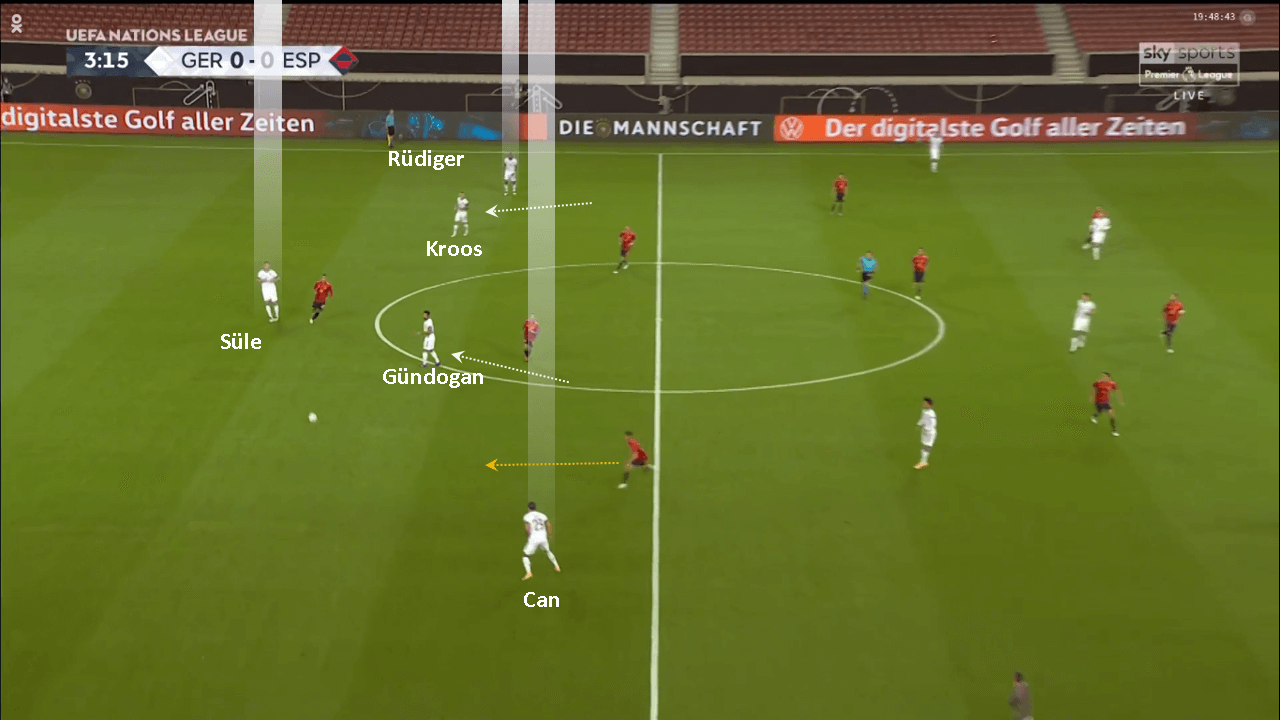
The biggest risk in playing with the centre-backs so wide apart is the distance to pass to each other, especially when they are higher up the pitch. Above we can see a case where Süle is playing a pass to Can, but this pass runs a big risk to be intercepted by Ferran, the left-winger. It was always necessary for Kroos and Gündoğan to drop to cover defensively in case of a turnover resulting in a defensive transition since it was impossible for Süle to cover all the defensive third alone himself. In most cases when the backline won possession of the ball and there was no immediate options, the ball was played back to Kevin Trapp.
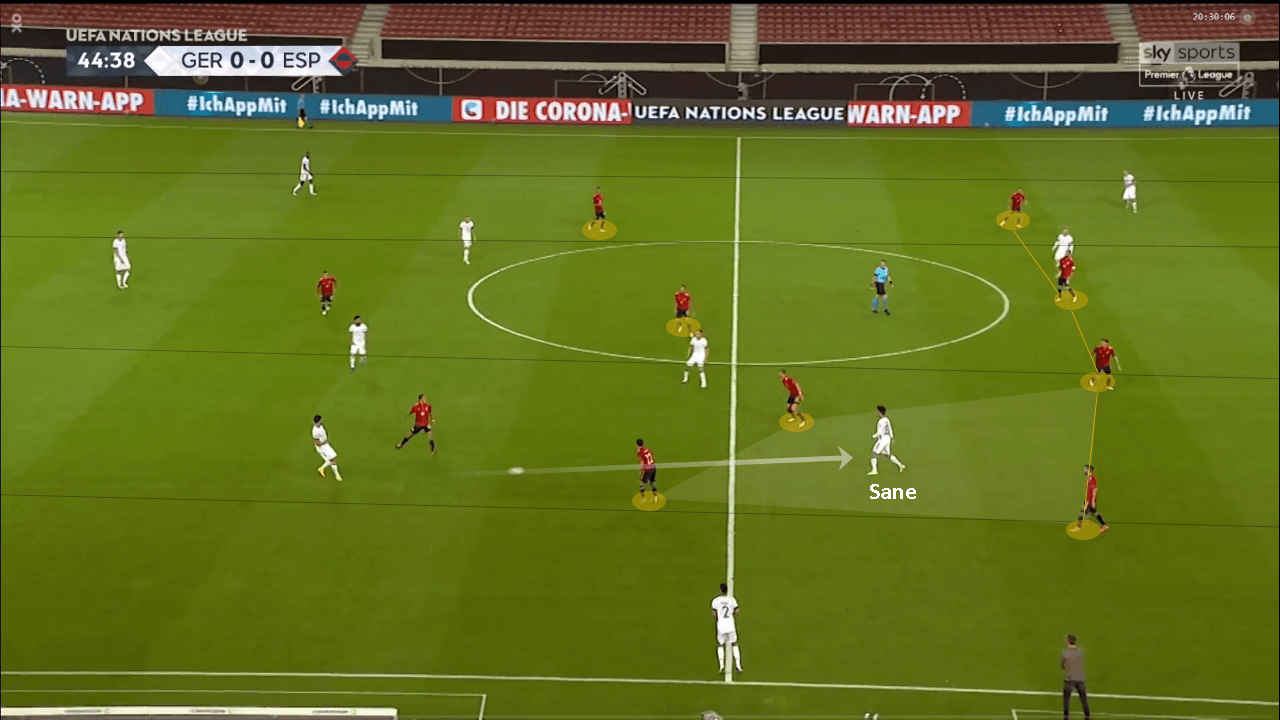
The reward was finding passes along the half spaces to the forwards, like this instance above. Can is able to find Sane who is positioned between the lines in the half space. Can’s freedom to drift so wide and off his defensive line gave him the ability to find passes like these. He could only commit to such actions with the security of Gündoğan or Kroos covering for him in case of a loss of possession.
Germany’s playing style overall involved breaking lines of pressure to play through Spain’s shape than to have players positioned wide to keep possession and play around them. We clearly see this behaviour in this instance below.

Here, Kroos has been passed the ball after a successful defensive transition. Kehrer, the wingback moves inside instead of staying wide along the touchline in his position. His movement allows Kroos to break the line of pressure and take out two players so that Kehrer can quickly turn and transition forward into attack. In this attack, he plays the pass to Sane who then plays Draxler through and Draxler registers a shot on goal.
Germany’s pressing organisation
Germany engaged in a man-oriented pressing right from the top when Spain played out from their keeper, David De Gea. The players were strictly assigned their markers, especially in midfield. The two strikers pressed the two centrebacks of Spain. Draxler was tasked at following Busquets everywhere on the pitch and marking him closely ensuring Spain wasn’t able to play out through Busquets.
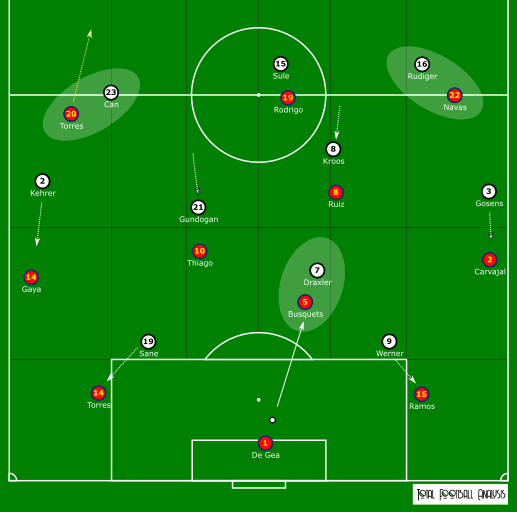
Kroos would similarly mark Fabian Ruiz and Gündoğan would mark Thiago out of possession, but they couldn’t be as strict with their marking as they had to make space for themselves for playmaking when they won possession. The wing-backs would pick the moment to aggressively press Spain’s fullbacks when the ball was played to their side. The wide centre-backs would also be left to deal with Spain’s wingers in a 1v1 situation as part of Germany’s high risk strategy.
Thiago was identified as the player who needed to be immediately closed down in midfield. Germany worked out a ploy to trap him positionally using Gündoğan, his assigned man-marker, Kehrer who would drift inside and Sane who would work back defensively. The three would form a triangle which would make him less of an option for his teammates to play.
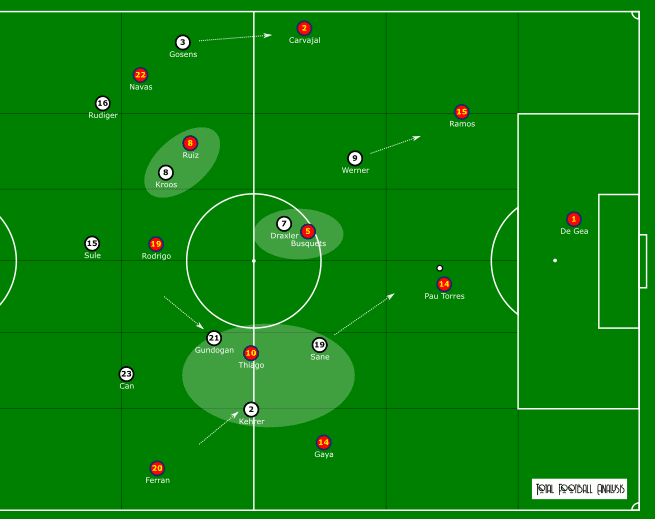
When Thiago was closed down as an option, the play was forced to be switched to the other side. As the ball was passed around through Spain’s centre backs, it was the trigger for Germany’s high press with Robin Gosens pushing up on Carvajal, Werner closing Ramos and Draxler and Kroos who were already man-marking Busquets and Ruiz respectively. As in this instance, the play would be forced back to De Gea who was compelled to play the long ball under this heavily man-marked situation.
With the wingbacks positioned so high up, and pressing aggressively in the line of the forwards, it was imperative for the wide centre-backs, Rüdiger and Can to win their aerial duels and close down the wingers if a long ball was played to them. The reason is, if Germany would allow Spain to find the space on the wings in their defensive third, it would become a cumbersome process to maintain this pressing system as the whole shape would have to transition back with a simple long diagonal ball.
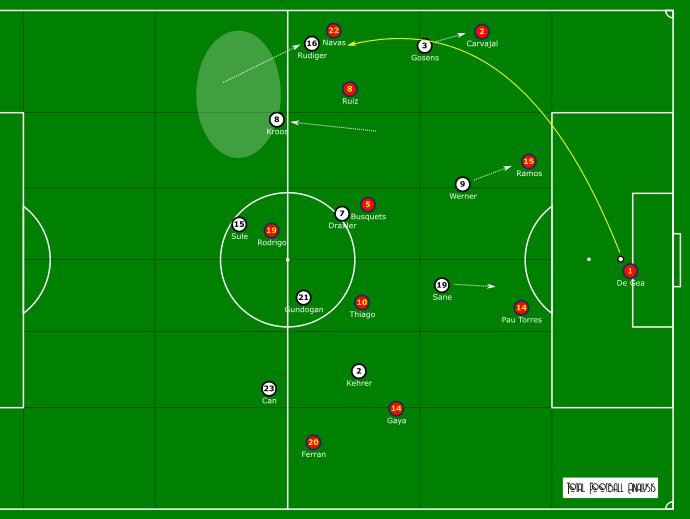
A look at Rüdiger‘s heatmap from Sofascore shows the areas higher up the pitch that he had to defend. Rüdiger would sometimes move far up into the opposition half like a fullback to close down Navas as he couldn’t afford to let a ball in behind, even if Kroos was positioned to cover for him. It was a similar risk taken by Can and some situations invited a lot of danger behind him from Ferran Torres.
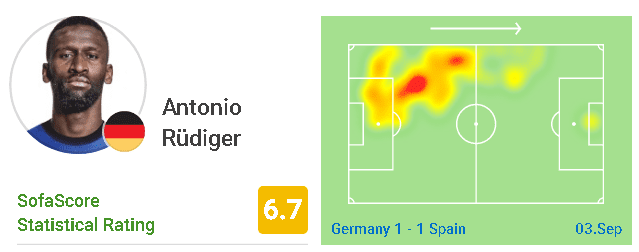
Trapp, the libero goalkeeper
Kevin Trapp had a crucial role in the organisation of possession from the back for Germany. Since Süle was so high up the pitch holding the line, and Rüdiger and Can were far apart, the only player with enough space and time to recycle possession and find a pass was Trapp. He played as a libero and helped in organising the attack from the back.
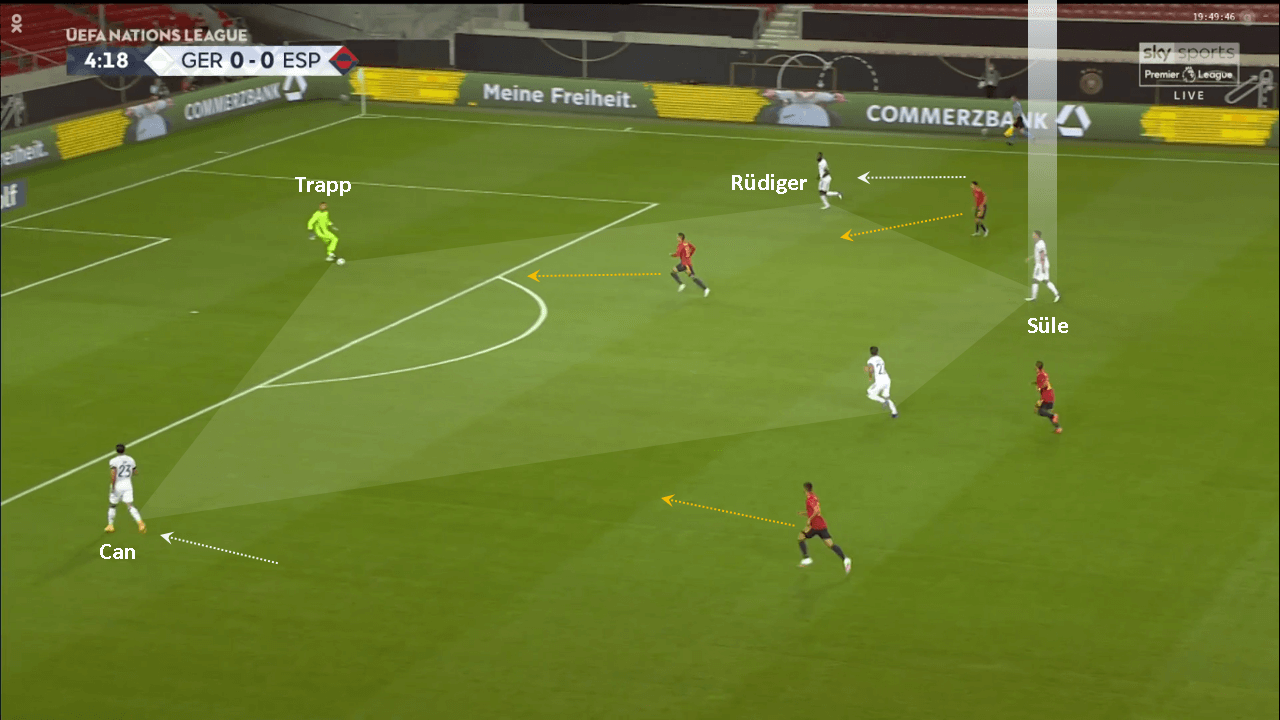
Above we can see a pass played back to Trapp. Süle would hold his position higher up instead of dropping to the line of the ball as a typical centre-back. He, along with Gündoğan or Kroos would provide the numerical superiority behind the first line of pressure, in this case, Rodrigo Moreno, who is pressing Trapp. Rüdiger and Can would drop from wide positions and would not be an immediate passing option since their body orientation allowed them to be easily pressed by wingers from behind. In this scenario, Trapp plays the chipped ball to the wingback on the right side, Kehrer who immediately tries to head it onto Sane and transition into attack.
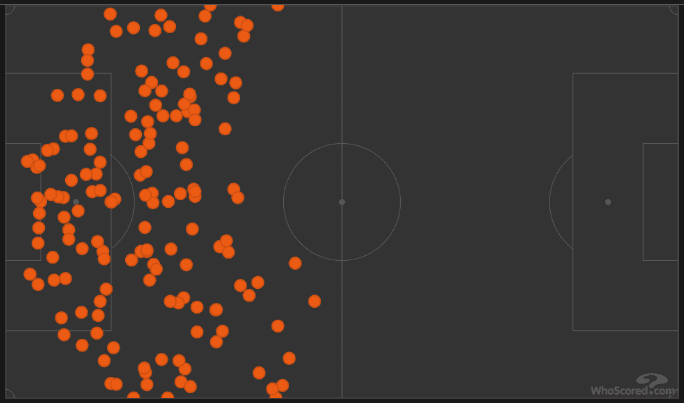
According to data from whoscored.com, Trapp played 63 passes, which was second to Kroos for Germany who played 65 passes. 34 out of 63 passes that Trapp played were short passes in the defensive third. This shows the importance of Trapp in the buildup and in organising possession from the back. Since he found himself in instances where he had to come way off his line to clear the loose balls, he almost left an open goal for Rodrigo and had to immediately engage in a slide tackle outside his box to stop Rodrigo. This moment was the height of the risk that Germany were taking at the back.
How Spain coped with Germany’s press
In the first half hour of play, Spain’s midfield was neutralised and the spaces that opened up for them were on the wide wings, with the diagonal long ball to the wingers. In order to make space for players like Thiago in the midfield, he needed to make movement off a third-man run. For this Spain needed to establish numerical superiority in the midfield against Germany’s man-to-man marking.
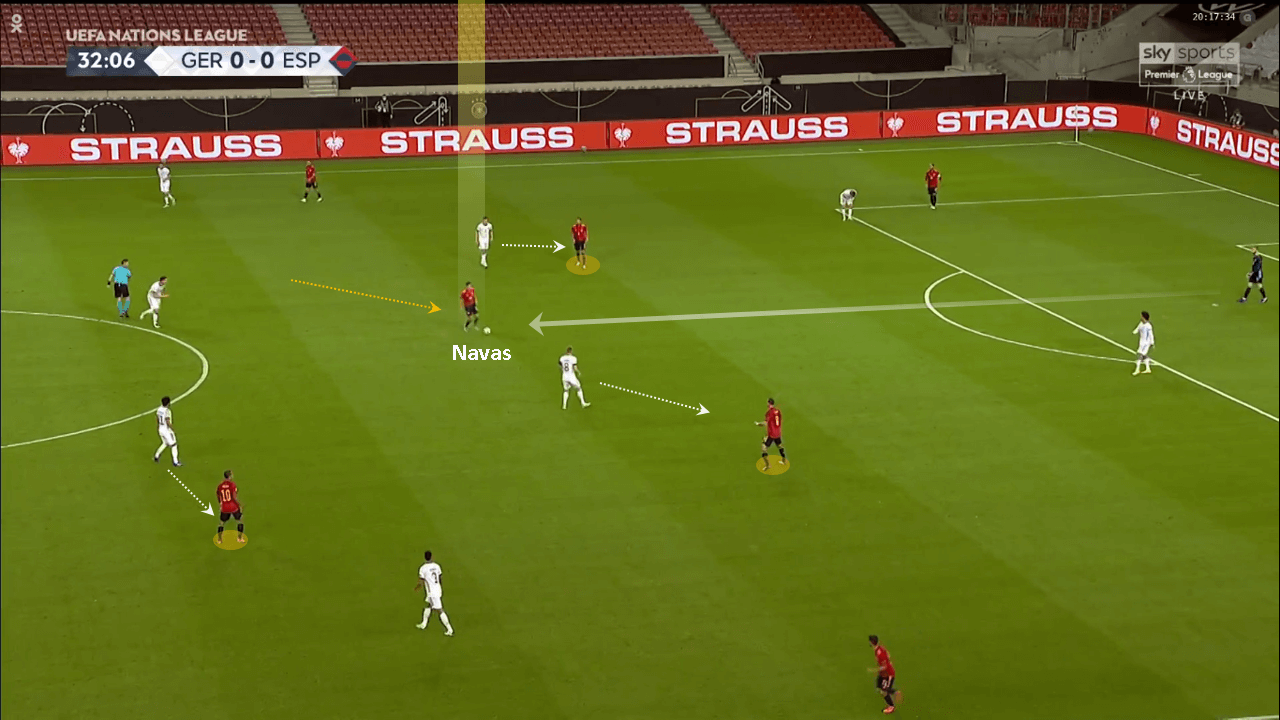
In this instance above, we see Navas moving into the midfield from the wide position to receive the ball. Since Rüdiger, playing as a centre-back couldn’t follow him into midfield leaving his position, and the other midfielders, Kroos, Draxler and Gündoğan were occupied with their players, it became 4v3 in midfield, and De Gea was able to play the pass to Navas.
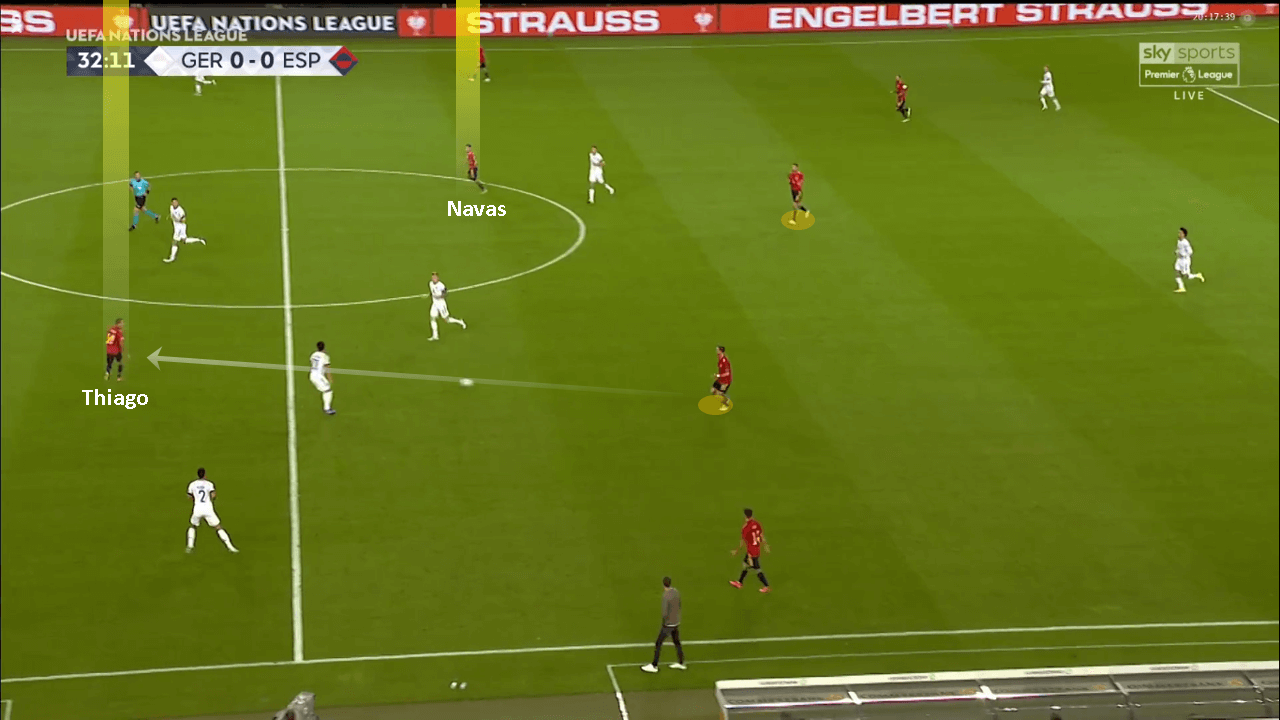
This movement took attention off Thiago for a moment, and he managed to lose his markers and position himself high up between the lines to receive a pass. This tactic was effective in breaking the press from Germany.
For this reason, in the middle of the pitch, Germany started to counter-press aggressively to win the ball back since it was a dangerous area to give the ball away with Süle and Can defending so high leaving all the space behind them for Spain to exploit in a counter-attack. Below we see Kroos, Gündoğan, Draxler and Werner, all four pressing to win the ball in the middle of the pitch.

Thiago’s intelligent movement off the ball was a constant antidote for Germany’s press as we can see in another instance below. Here the ball is played to Pau Torres and Sane, knowing that Ramos will be pressed by Werner on the left, and Gayà will be pressed by Kehrer on the right is looking to close the space to the centre-back. Thiago manages to sneak behind him and checks his shoulder to make sure he is free to receive a pass. We also see Gündoğan yelling at Sane that Thiago is behind him, but it’s too late. Thiago receives the pass and plays a chip in behind the defence with his next touch.
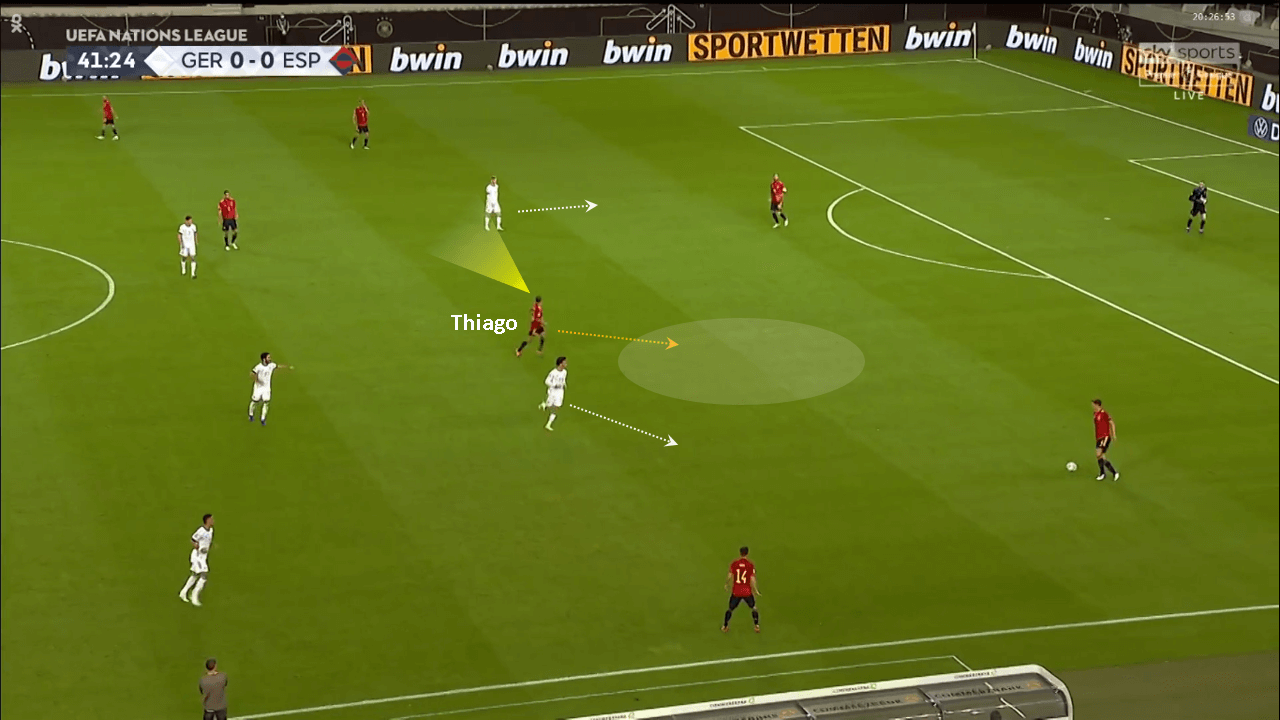
Change of tactics in the second half
Germany continued their strategy until an in form Werner found the back of the net from a quickly organised counter with a beautiful goal. From then on, Germany decided to sit back and defend the lead for the rest of the game. They sat back in a 5-4-1 with the wingbacks defending deeper along the line of the three centre-backs. Sane and Draxler moved wide alongside Kroos and Gündoğan leaving Werner up top to attack the space in case of an attacking transition.
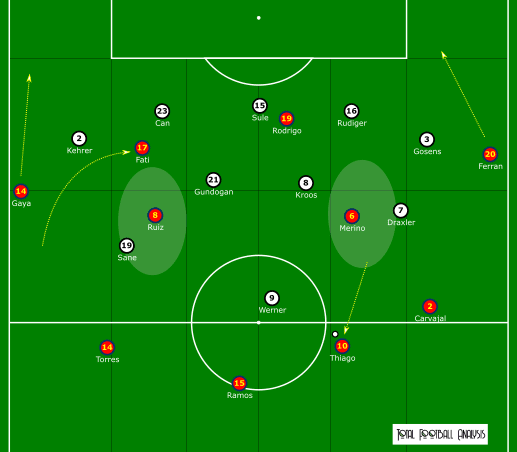
Luis Enrique brought on Ansu Fati at half time for Navas and this introduced a fresh dynamic to Spain’s attack. He played on the left wing with Ferran Torres switching to the right-wing. Fati was able to drift into the left half space and dominate it by always being positioned between the lines to receive the passes from deep. Germany player more defensively after taking the lead made it much easier for Fati.
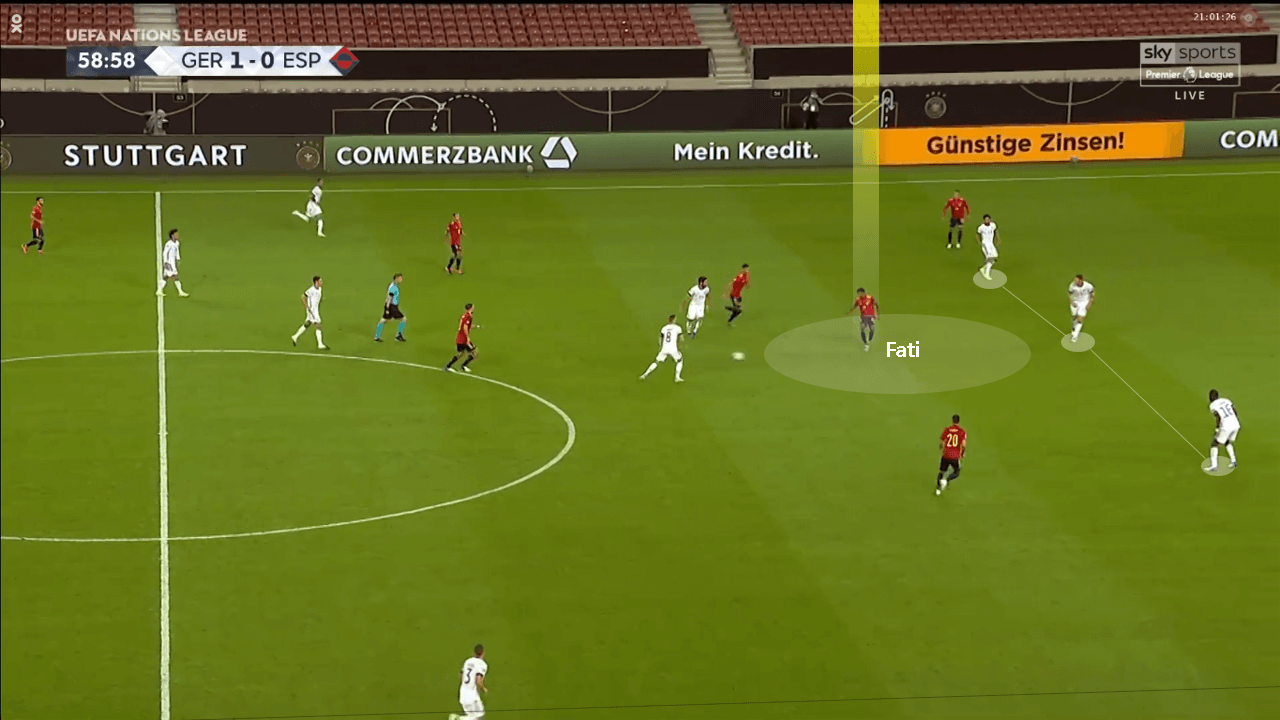
Above we can see Fati receiving the ball between the lines in the left half space. Fati drifting inside also allowed Gayà to overlap him on the left-wing. Below is a map of Fati’s touches during the game and you can see how dominant he is in the half space playing between the lines. He completed two dribbles and made one key pass.
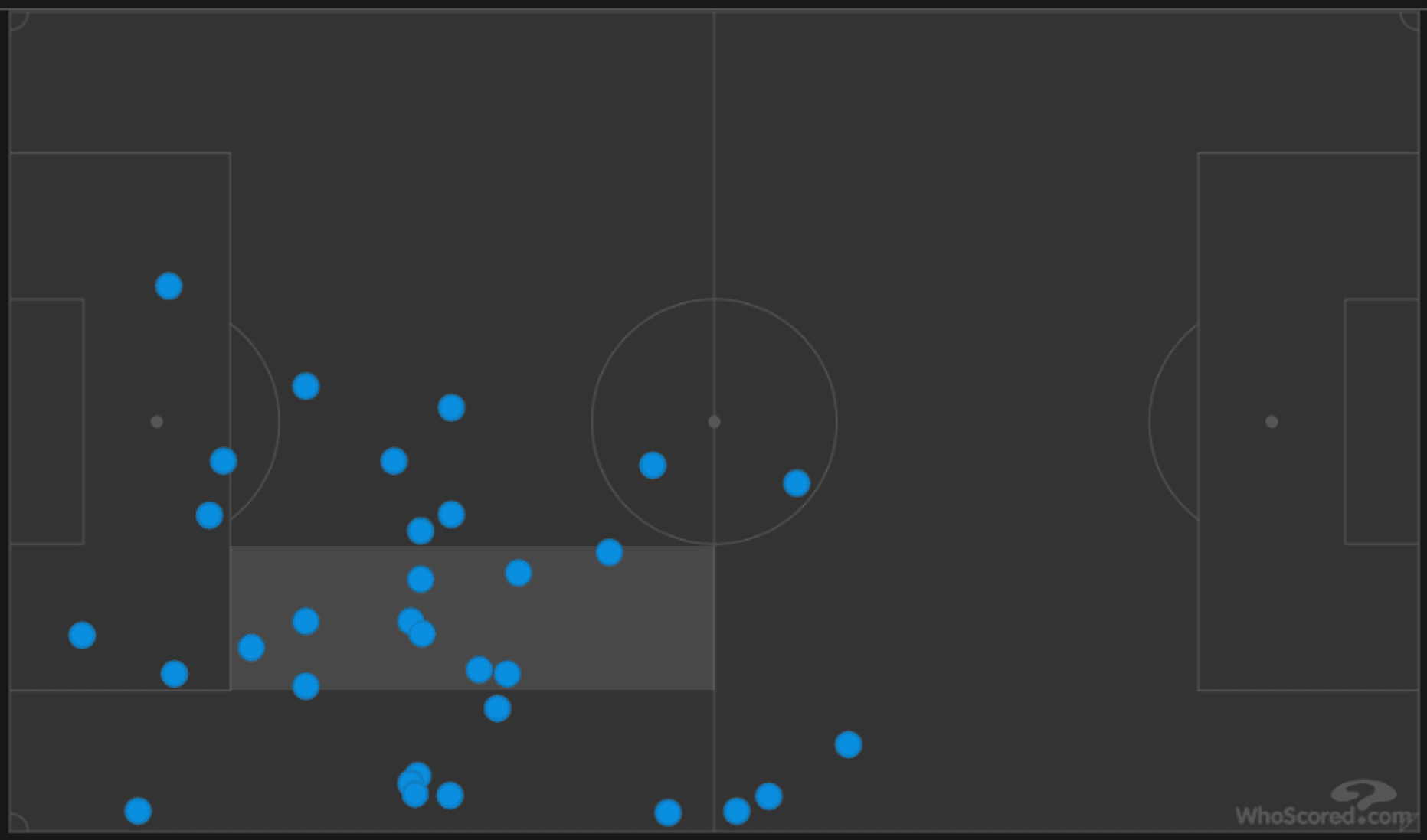
The threat for a counter-attack from Germany always existed but was far lesser in the second half with Germany sitting deep. Germany looked to exploit the spaces behind the Spanish defence once the ball was won as with Can in this instance below who went on to register a shot on target.
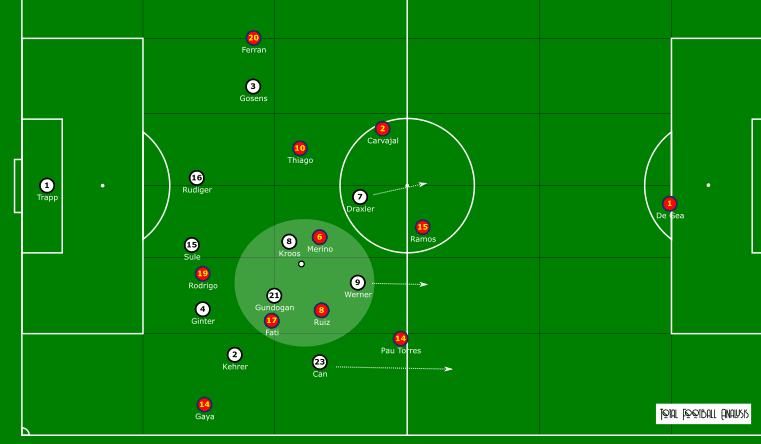
Against Germany defending in a low-block, Spain were able to attack more positionally. A key tactic of Spain’s positionally strategy in the second half apart from Fati’s role was the wide positioning of Torres. Spain was able to Ferran as a free man on the right side to capitalise on his dribbling ability since he had more space next to the touchline.
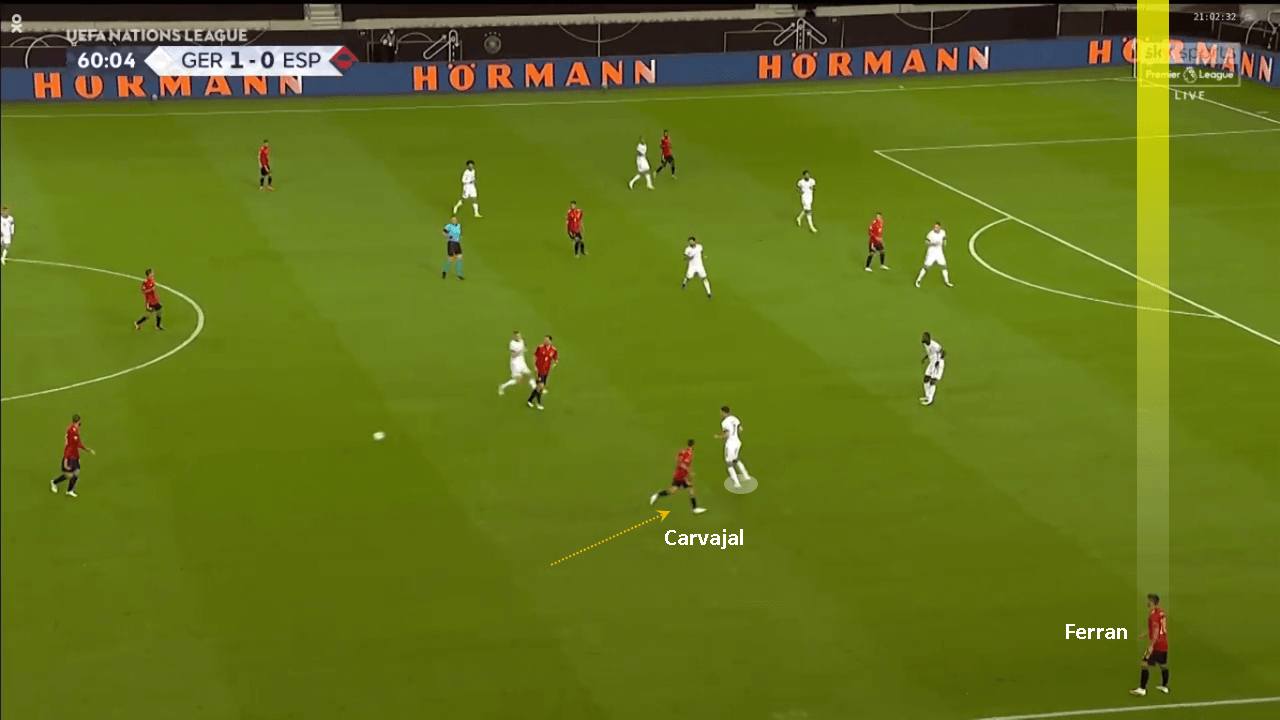
Germany were also defending narrow and Gosens was occupied with Carvajal, the right-back running at him in the right half space as we see in this scenario above. Rüdiger was too far and couldn’t leave his position to close down Ferran. This gave him all the room to dribble along the right and put early crosses into the box. He was able to set up the goal for Spain in the dying seconds in this way.
Conclusion
Spain’s comeback showed the quality of their young players to change the outcome of the game. Fati displayed a strong performance in his first international cap for Spain and proved to be a vital force for the national side in future games. Spain’s performance also highlighted the technical prowess and intelligence of Thiago and Ruiz to find spaces in the midfield despite Germany’s press.
Germany got their tactics right to dominate the first half and get the early lead. Despite carrying its risk, their man-to-man press and counter-attack strategy neutralised Spain for much of the first part of the game. But after their lead, their decision to switch to total defence backfired and Spain’s equaliser was beckoning by the waves of attack that kept coming onto Trapp’s goal. Although Germany did have their occasional chances in the counter-attack, it perhaps would have been wiser to push for the second goal before switching to an all-out defence tactic from Löw. A point for each of the two places them below Ukraine who secured three points in their win against Switzerland.





Comments